硕士学位论文
面向 5G 的 Polar 码编解码技术研究
ENCODING AND DECODING TECHNOLOGY OF
POLAR CODES TOWARDS 5G APPLICATIONS
高翔
哈尔滨工业大学
2017 年 12 月
�
国内图书分类号:TN911.22 学校代码:10213
国际图书分类号:621.3 密级:公开
工学硕士学位论文
面向 5G 的 Polar 码编解码技术研究
硕 士 研 究 生 : 高翔
导 师 : 吴绍华副教授
申 请 学 位 : 工学硕士
学
科 : 信息与通信工程
所 在 单 位 : 深圳研究生院
答 辩 日 期 : 2017 年 12 月
授予学位单位 : 哈尔滨工业大学
�
Classified Index: TN911.22
U.D.C: 621.3
A dissertation submitted in partial fulfillment of
the requirements for the academic degree of
Master of Engineering
ENCODING AND DECODING TECHNOLOGY OF
POLAR CODES TOWARDS 5G APPLICATIONS
Candidate:
Supervisor:
Academic Degree Applied for: Master of Engineering
Speciality:
Gao Xiang
Associate Prof. Wu Shaohua
Affiliation:
Date of Defense:
Degree-Conferring-Institution: Harbin Institute of Technology
Information and Communication
Engineering
Shenzhen Graduate School
December, 2017
�
哈尔滨工业大学工学硕士学位论文
摘 要
互联网技术于近年有了长足发展,涌现出的海量信息数据向现有通讯系统提
出了更高要求。第五代移动通信体系(The 5th Generation Mobile Communication,
5G)作为当前研究热点,着力解决数据的超高速、超可靠、低时延传输问题。这
些问题对无线通信物理层的核心模块——信道编码,提出了更难满足的需求。近
年提出的 Polar 码源起于信道极化现象,是当下唯一可达香农极限传输的信道编码
方式。经过学术界、产业界的共同全力推动,近几年 Polar 码的研究取得了丰富的
成果累积。2016 年 11 月,3GPP 决定将 eMBB 场景下控制信道的短码标准定为 Polar
码。尽管如此,Polar 码在匹配 5G 实际应用场景的传输需求时仍有诸多不足:点
对点传输方面,Polar 码虽然无需随机编码或迭代译码,但唯有码长足够长时才能
使信道充分极化,故单纯的 Polar 短码纠错能力和抗衰落能力较差;网络通信的中
继传输方面,编码协作结合 Polar 码能够为多用户信息传输带来分集增益和编码纠
错增益,但针对可变协作程度,当前研究缺乏高性能的分码字构造方案;网络通
信的多址接入传输方面,由于 MAC(Multi-Access Channel)在传输时是多个用户
分享同一时段或频段进行信息传送,面向多址接入信道的 Polar 低复杂度传输方案
亟待设计。
针对以上问题,本文从三个方面对面向 5G 应用的 Polar 码进行了深入研究:
单链路方面,研究了如何改善 Polar 短码性能。为了改善 Polar 短码误码率高,
抗衰落能力差的劣势,首先选取纠突发错误能力强的 Reed-Solomon(RS)码设计
了多段 RS 码保护下的级联 Polar 码方案。其次针对每个子信道错误概率不服从均
匀分布的特点,引入了基于蒙特卡罗仿真估计的码率分配举措,再配合 RS 码和
Polar 码各自的编码特点引入了帧内、外交织,最终结合接续消除列表(Successive
Cancellation List, SCL)算法与 RS 译码算法设计了联合译码器。仿真结果表明,该
级联方案改善了纯 Polar 短码在瑞利快衰落信道下的性能表现。
中继通讯场景方面,针对怎样改善 Polar 码编码协作性能开展研究。在中继信
道下,目前有关 Polar 码编码协作的研究较为缺乏,且仅在协作程度为 50%时有较
好的性能增益。为了设计在任意编码协作程度均有较好性能的分码字构造方案,
本文首先针对极化子信道容量与 Polar 码自身码重的特征,提出了高效的凿孔算法
设计原则。在低复杂度的前提下,还配合回溯算法对凿孔后的编码信息位联合优
化,降低了凿孔带来的性能损失。随后,利用该分码字构造方案产生分码字,并
在译码端部署迭代次数可灵活调节的软消除(Soft Cancellation, SCAN)译码器,
配合周期冗余校验(Cyclical Redundancy Check, CRC)实现了减少多余译码延迟的
且性能更佳的 Polar 编码协作方案。
- I-
�
哈尔滨工业大学工学硕士学位论文
最后,对多址接入信道的极化与 Polar 编解码方案展开研究。多址接入信道方
面,直接应用码率分割译码或采用传统的信道极化方式所设计出的编译码方案无
法达到容量域优势面上的任意点。为实现可达优势面上任意点的低复杂度 Polar 编
译码方案,本文以两用户多址接入信道为例,首先使用互信息单调链式展开法则
证明了信道容量域优势面上任意码率对的可达性,接着延续该思路证实了该信道
同样存在极化现象,类比单用户 Polar 译码时的似然概率递归计算方式,给出多址
接入信道下的递归求解公式,凭借递归形式实现了适用于多址接入信道的接续消
除(Successive Cancellation, SC)译码算法。最后,将 MAC-SC 向 SCL 算法拓展,
实现了适用 MAC 的 SCL 算法。上述编译码方案不仅继承了单用户情景下的复杂
度,仿真证明采用该方案可达到优势面上的任意码率对。
关键词:5G;Polar 码;级联;凿孔;多址接入信道
- II-
�
哈尔滨工业大学工学硕士学位论文
Abstract
With the rapid development of the internet, existing communication technical
framework is challenged by the massive data stream. As a popular research topic, the
5th generation mobile communication system (5G) is mainly focusing on solving the
ultra-high speed, ultra-reliable and low-lantency transmission problems. These problems
put forward more requirements for channel coding, which is the core component of the
physical
layer of wireless communication. Derived from channel polarization
phenomenon, Polar codes are the only family of codes which can theoretically achieve
Shannon limits. Due to the fruitful results created by academia and industry, 3GPP
standardize Polar codes for control channel in 5G eMBB scenario. However, there are
still some noticeable bottlenecks for the practical applications of Polar codes. Although
long Polar codes can reach the Shannon limit without random encoding, short Polar
codes have poor error correction capacity because of insufficient polarization. As to the
relay network communication scenario, Polar coded cooperation can bring diversity
gains and error correction gains simoutaineously. But until now, there are few studies on
sub-codewords design for variable cooperation level. For the multiple access
transmission of network communication, MAC (Multiple access channel) shares same
time interval or frequency interval to send multiple users’ information. Specific plans of
Polar coding & decoding under MAC should be studied urgently.
Aiming to the above questions, whole research is composed of three aspects:
For the single link transmission, methods to improve the performance of short
Polar codes are studied. To compensate the poor error performance of short Polar codes,
RS codes are chosen to develop a multi-RS codes concatenation scheme of Polar codes.
Specifically, the code rate of every RS frame is adaptively allocated based on the error
pattern estimated by Monte-Carlo algorithm. After using the frame & intra-frame
interleaver, the performance of short Polar codes under fading channels is well
improved with the help of SCL-based (Successive Cancellation List decoder) joint
decoder. Simulation results show that the concatenation scheme enhances the short
Polar codes performance under fast fading channels.
On the aspect of relay channel, the research of improving the performance of Polar
coded cooperation is conducted. Under the relay channel communication scenario, few
researches about Polar coded cooperation have been studied, high performance can be
obtained only at 50% cooperation level. Based on the polarization channel capacity and
the feature of Polar codes’ minimum hamming weight, a low-complexity puncture
algorithm is proposed. With the help of information refreezing algorithm, nice
performance can be reached under any cooperation level (puncture number). In addition,
a soft cancellation decoder (SCAN) based scheme can reduce the redundant decoding
- III-
�
哈尔滨工业大学工学硕士学位论文
delay by cyclical redundancy check (CRC) results generated by the cooperative user.
At last, the polarization phenomenon of multiple access channel and the
corresponding coding & decoding techniques are well studied. On the aspect of multiple
access channel (MAC), few points on the dominant face of MAC rate region can be
reached using the rate splitting decoding or original channel polarization. Taking
two-user MAC as an example, the monotone chain rules expansion is deployed to
realize practical Polar transmission schemes of MAC that can achieve all points on the
dominant face. After the polarization phenomenon of MAC is proved, recursive
calculation formulas of single user can be extended to MAC. So, SC & SCL can be
extended to MAC as well. The above Polar coding scheme of MAC inherits the
complexity of single user coding scheme, simulation results show that MAC-SC and
MAC-SCL can achieve any points on the dominant face of rate region.
Keywords: 5G, Polar codes, concatenation, puncture, multiple access channel
- IV-
�
哈尔滨工业大学工学硕士学位论文
目 录
摘 要 ............................................................................................................................ I
Abstract ........................................................................................................................ III
第 1 章 绪 论 ............................................................................................................. 1
1.1 课题研究背景与意义 ....................................................................................... 1
1.2 国内外研究现状及分析 ................................................................................... 2
1.2.1 Polar 码的编译码研究现状 ....................................................................... 2
1.2.2 Polar 码级联的研究现状 ........................................................................... 4
1.2.3 Polar 码应用于网络通信场景的研究现状 ............................................... 5
1.3 现阶段研究存在的问题与不足 ........................................................................ 5
1.4 本文研究内容 .................................................................................................... 6
第 2 章 信道极化理论与 Polar 码的编译码技术 ....................................................... 8
2.1 引 言 .................................................................................................................. 8
2.2 Polar 码背景知识体系 ....................................................................................... 8
2.2.1 信道极化原理 ............................................................................................. 8
2.2.2 Polar 码的编码及信息位选取算法 ....................................................... 12
2.2.3 Polar 码的译码算法 ............................................................................... 16
2.3 仿真与结果分析 ............................................................................................. 21
2.3.1 不同译码算法的性能分析 ....................................................................... 21
2.3.2 非系统 Polar 码与系统 Polar 码之间的性能对比 ................................. 24
2.4 本章小结 ......................................................................................................... 25
第 3 章 单链路高性能 Polar 码级联方案设计 ......................................................... 27
3.1 引 言 ............................................................................................................... 27
3.2 RS 码的背景知识 ............................................................................................. 27
3.2.1 RS 码的编码 ............................................................................................. 27
3.2.2 RS 码的译码 ............................................................................................. 28
3.3 多段 RS 码保护下的 Polar 码级联方案设计 ................................................ 29
3.3.1 帧间交织器设计与码率分配 .................................................................. 29
3.3.2 帧内交织器设计 ...................................................................................... 32
3.3.3 基于 SCL 的联合译码算法设计 ............................................................ 33
3.4 仿真与结果分析 ............................................................................................. 35
3.4.1 译码开销与复杂度分析 .......................................................................... 35
3.4.2 仿真结果分析 .......................................................................................... 36
3.5 本章小结 ......................................................................................................... 38
第 4 章 中继信道 Polar 码编码协作方案改进 ......................................................... 39
- - V
�
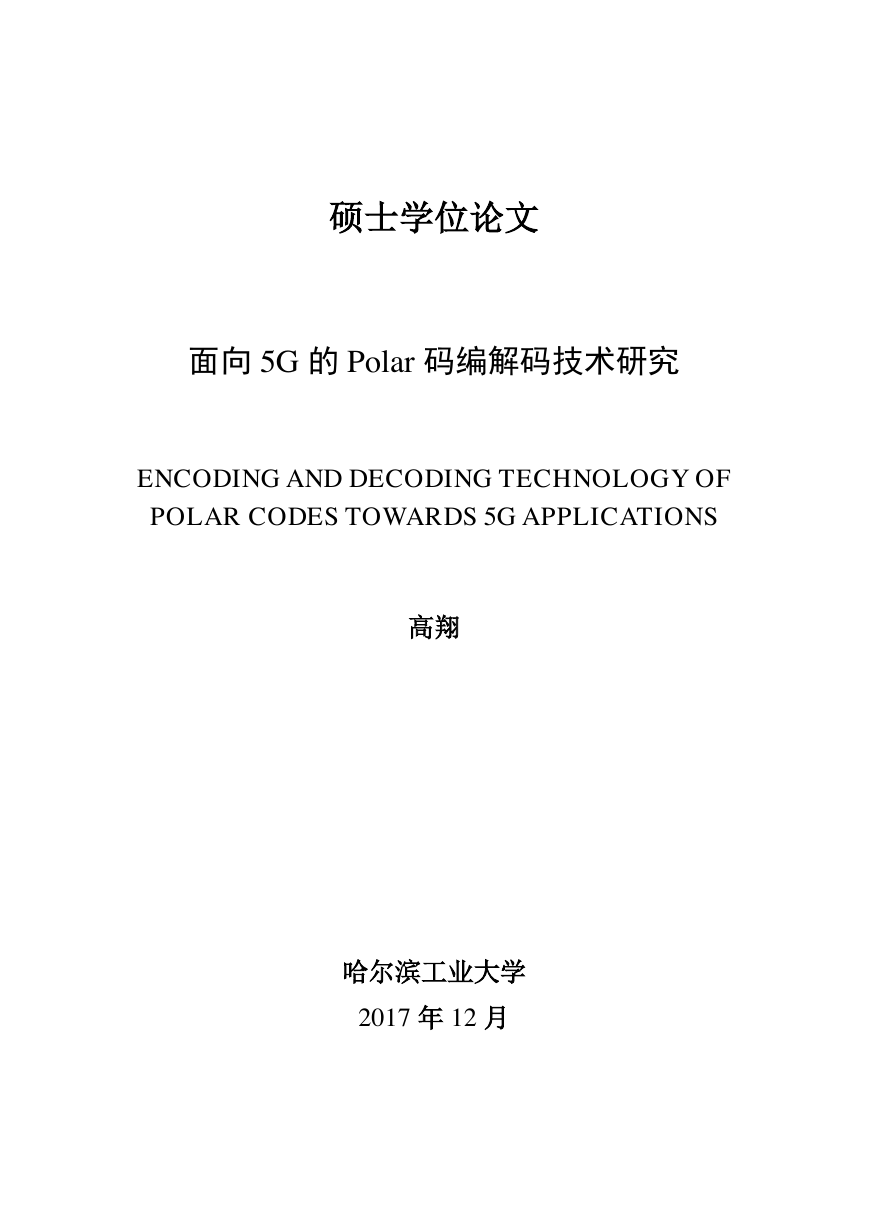
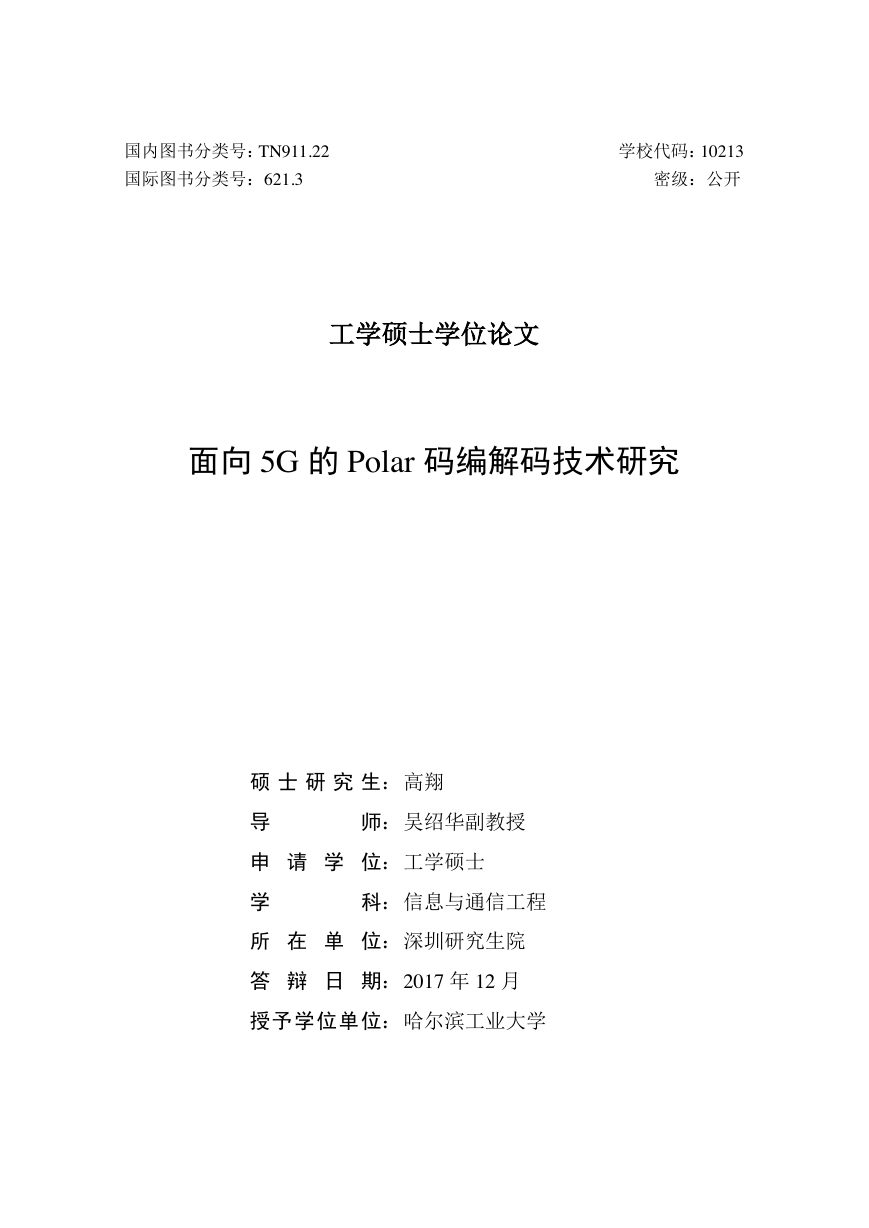
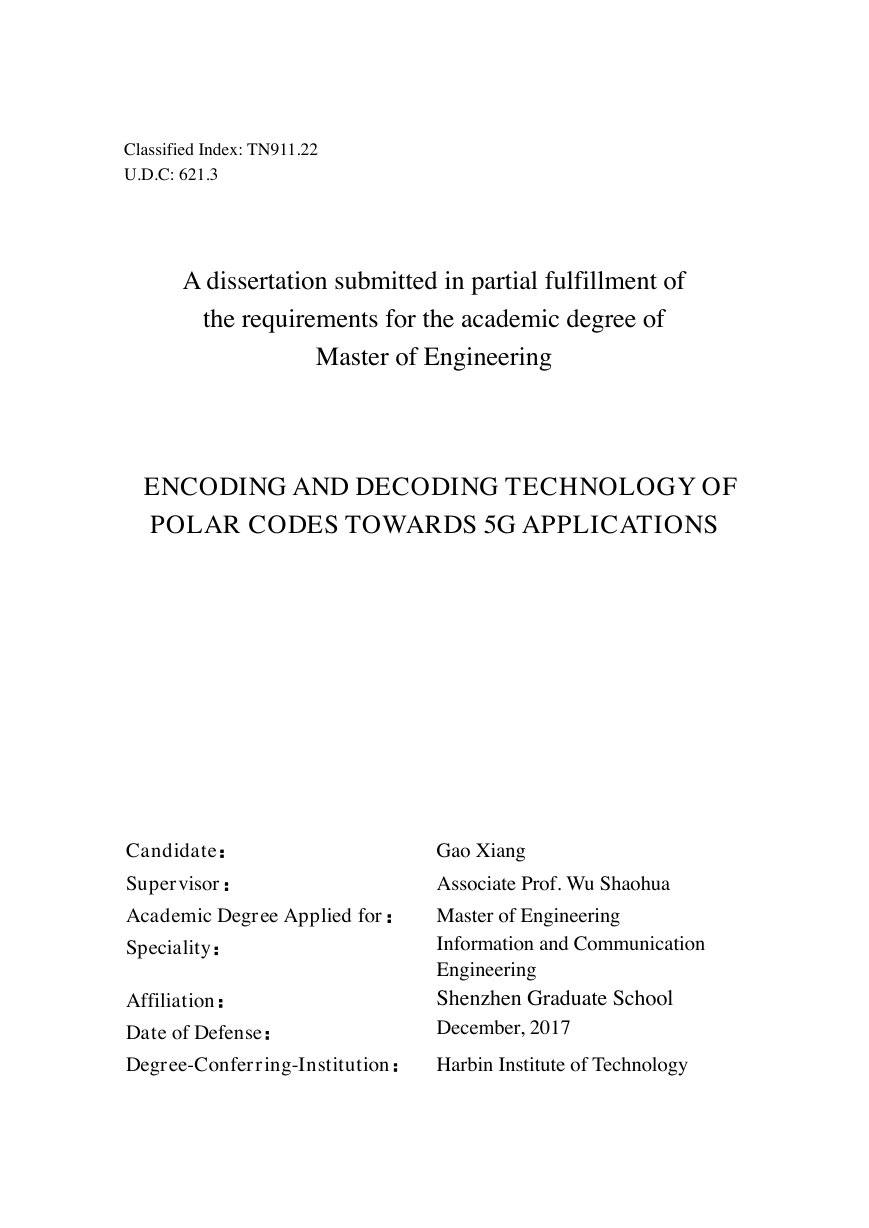
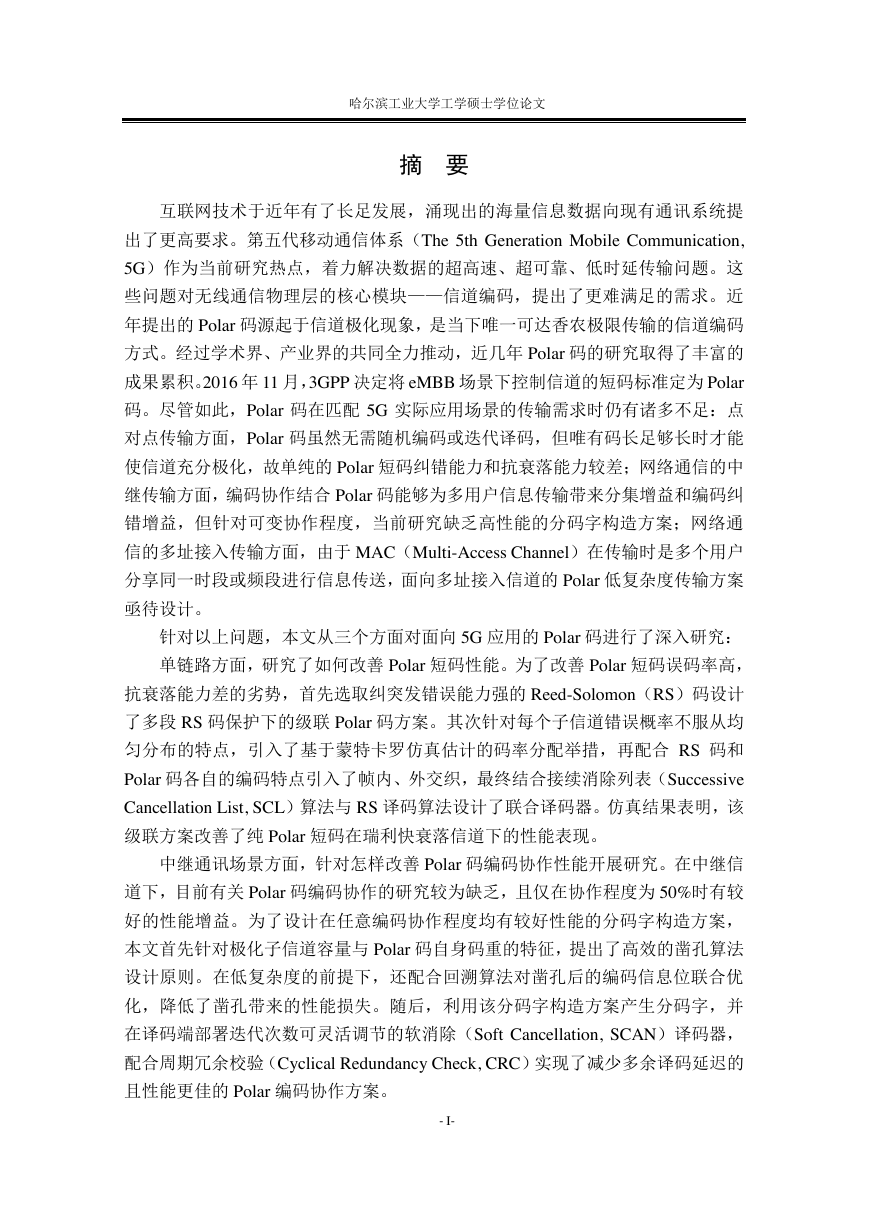
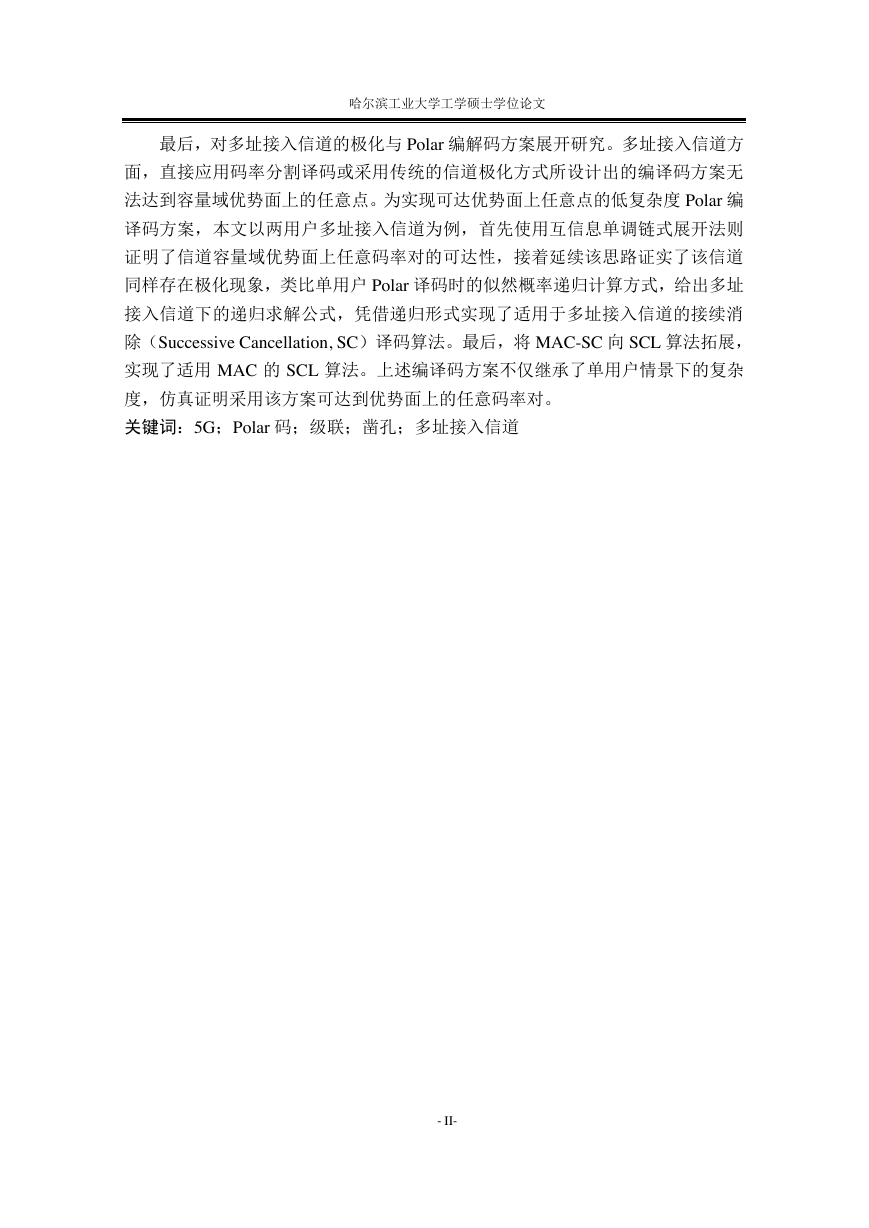


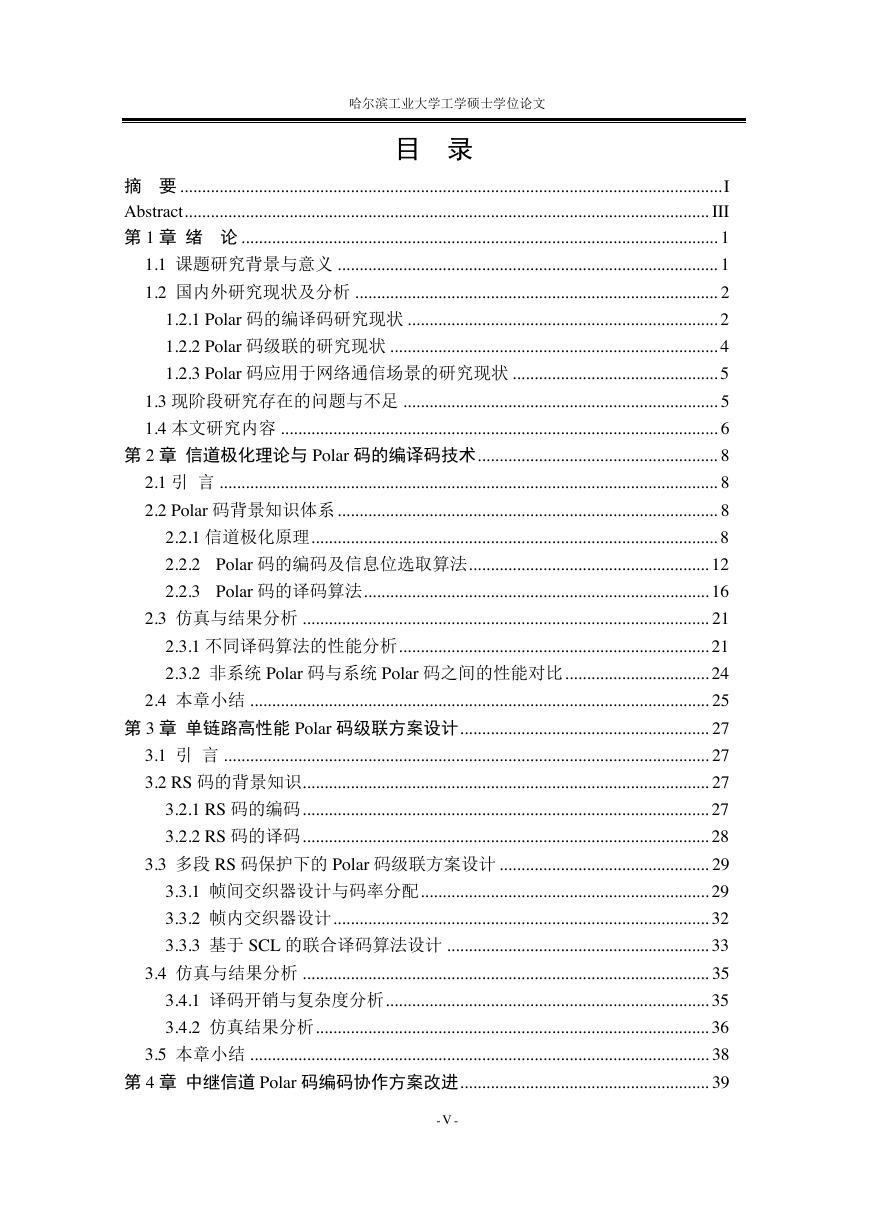








 2023年江西萍乡中考道德与法治真题及答案.doc
2023年江西萍乡中考道德与法治真题及答案.doc 2012年重庆南川中考生物真题及答案.doc
2012年重庆南川中考生物真题及答案.doc 2013年江西师范大学地理学综合及文艺理论基础考研真题.doc
2013年江西师范大学地理学综合及文艺理论基础考研真题.doc 2020年四川甘孜小升初语文真题及答案I卷.doc
2020年四川甘孜小升初语文真题及答案I卷.doc 2020年注册岩土工程师专业基础考试真题及答案.doc
2020年注册岩土工程师专业基础考试真题及答案.doc 2023-2024学年福建省厦门市九年级上学期数学月考试题及答案.doc
2023-2024学年福建省厦门市九年级上学期数学月考试题及答案.doc 2021-2022学年辽宁省沈阳市大东区九年级上学期语文期末试题及答案.doc
2021-2022学年辽宁省沈阳市大东区九年级上学期语文期末试题及答案.doc 2022-2023学年北京东城区初三第一学期物理期末试卷及答案.doc
2022-2023学年北京东城区初三第一学期物理期末试卷及答案.doc 2018上半年江西教师资格初中地理学科知识与教学能力真题及答案.doc
2018上半年江西教师资格初中地理学科知识与教学能力真题及答案.doc 2012年河北国家公务员申论考试真题及答案-省级.doc
2012年河北国家公务员申论考试真题及答案-省级.doc 2020-2021学年江苏省扬州市江都区邵樊片九年级上学期数学第一次质量检测试题及答案.doc
2020-2021学年江苏省扬州市江都区邵樊片九年级上学期数学第一次质量检测试题及答案.doc 2022下半年黑龙江教师资格证中学综合素质真题及答案.doc
2022下半年黑龙江教师资格证中学综合素质真题及答案.doc